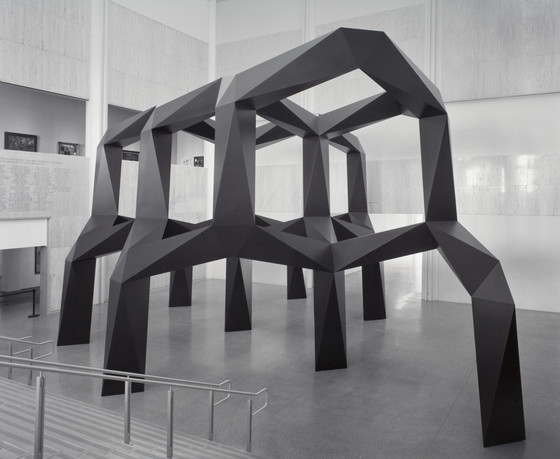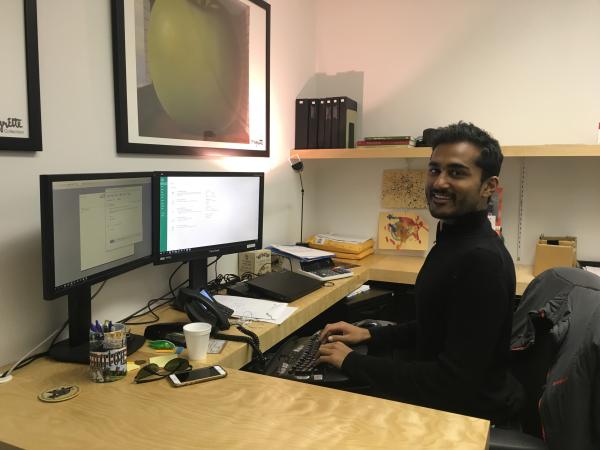Unframed is taking a look behind the scenes to profile the creative, dedicated people who make LACMA special. We sat down with budget manager Arun Mathai to talk about how he fell into museum work, his love for dance, and being surrounded by art and artists.
What do you do at LACMA?
I work in the finance office. My primary responsibility is to help set up and manage the budget for the museum, specifically the operating budget and everything that's involved in running the museum.
What was your path to LACMA?
Very non-linear! I was a business administration major in undergrad. My first job after I graduated was at a department store, training to be a buyer. I was working in their central office learning about planning and merchandising, but a few months after I started the store was bought out, so I started job hunting. It was the most random search that got me here: there was a Craigslist post for a purchase order analyst at LACMA and I thought, "I've worked with purchase orders as a buyer. I can do this, sure." I came in for an interview and, eventually, I got a call from HR saying that they actually had another position for me: financial analyst. I accepted, and I started on August 1, 2006.
You’ve been here for over 10 years!
It’s pretty crazy to think about, but I really like working here. I love the culture within the finance office; it’s a really great environment. One of the great perks about being in finance at this institution is that I’m learning a lot about non-profit arts administration. Though I have a lot of experience in the arts, performing arts specifically, it’s been nice to learn about the administration side of things. You end up with a very balanced perspective.

What's your favorite artwork at LACMA?
Smoke. I think a big part of it has to do with the scale of the sculpture. It's so impressive to see, and to walk under and around. One of my favorite things about it is that, depending on your angle or perspective, the piece looks completely different. It fits so beautifully in the atrium, where it is now. I could sit and stare at it, or walk around and look at it, for a very long time. I love it. It's a great piece.
You mention you have a lot of experience with performing arts. Tell us about that.
I started dancing when I was seven, and I haven't stopped. My primary training is in a classical style of Indian dance called Bharatanatyam, and I trained with my guru, Sundara Swaminathan, at Kala Vandana Dance Center, up in the SF Bay Area. I'm one of the few men in the U.S. who actually perform this dance style. I've been performing it somewhat regularly, and I try to go to India every year to take more classes and perform if I can. I love dancing. I love the high you experience when you're on stage—it's incredible.
How did you first get into dancing at the age of seven?
My parents moved here from India. I think my parents and many of their peers were looking for any means to keep their kids somewhat familiar with their culture. Even though we’re neither Hindu nor from the Indian state where this particular dance style, Bharatanatyam, is from, dance class was one of the few ways for South Asian immigrants to provide their daughters, but not necessarily their sons, a cultural tie back to their homeland in the ‘80s.
My sister is nine years older than me. My brother and I were too young to stay home alone, so my mom would drag us along and I would sit quietly at the back of the class and watch. I was three or four, and my parents say that, at home, when I thought nobody was watching, I would try imitating the movements I saw my sister do in class. I would go so far as to get up on the coffee table and dance! But if I realized that anyone was watching, I would run and hide behind the curtains—I was very bashful about it. My parents were encouraging, though, and they asked a number of times if I wanted to start, but I kept saying no. Finally, when I was seven, I said I wanted to start, and I have been dancing ever since.
How does dance interact with your professional life?
For the most part they are separate, but one of the great things about having so much experience being on stage is that I don't have any fear of speaking in public, or presenting, which has come in handy at work a few times. I’ve been fortunate enough to find a full-time career where I can still pursue dance professionally. My supervisors are very flexible in terms of my schedule, so I can take time off as needed to rehearse and tour and perform. Mark and Ann, my supervisors, are incredibly supportive. They have actually come to a few of my performances.
And you’ve also started collaborating with Bindu Gude, the associate curator for south and southeast Asian art, for a dance series for LACMA’s Facebook Live audience.
There are a number of objects in the collection that tie directly to Bharatanatyam, the classical style of dance I do. The origin of this dance style is rooted in Hindu mythology. The classical Indian arts were often used as a means to convey religious stories and concepts, so it makes sense that the subject matter of these sculptures and paintings would tie very directly to the subject matter of Indian music and dance. We were looking at the sculptures and some of the paintings on display, and we thought it would be neat if she talked about the works from an art historical perspective, and I could perform and discuss the shared inspiration.
Tell us something about LACMA that only you know.
Everybody in the finance office is an artist in some way, shape, or form. Though I won’t call everybody out, I will mention that my boss, Mark, is a musician, and Ann, our CFO, is a dancer who used to tour and perform regularly. I'm surrounded by artists!
The conversation was condensed and edited for clarity.



